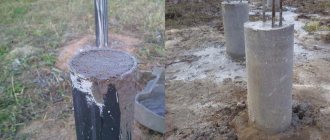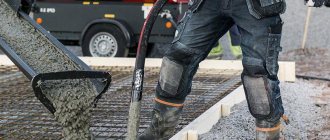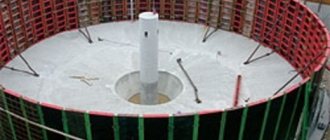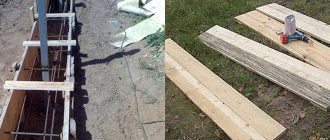A concrete pump is a unit that supplies freshly prepared mortar from the point where it is unloaded from a concrete mixer truck to the working area. Modern craftsmen cannot imagine carrying out repair and construction work without a concrete pump, which greatly simplifies and speeds up all stages where concrete and other mixtures are involved.
Most often, concrete pumps are used in the process of monolithic construction. Industrially produced units are quite expensive, but if you have the drawings and all the necessary materials, tools, as well as the necessary patience to strictly follow the instructions and standards, you can make a concrete pump yourself.
Externally, it will differ from the factory models, but the quality of work and the performance of all necessary functions will be identical. Subject to significant cost savings, a homemade concrete pump becomes the most preferable option for many.
What types of concrete pump designs exist?
Depending on the type of drive, concrete pumps can be hydraulic or mechanical. According to the design, pistonless and piston ones are poured. Depending on the method of movement, concrete pumps are either stationary or mobile. Despite the apparent diversity, today two types of concrete pumps are used in construction: piston (with hydraulic drive) and rotary (with mechanical drive).
In a rotary unit, the mixture is supplied by rollers equipped with the rotor housing: during the process of rotation, they press on the supply hose and the concrete is thrown out from there. But it is very difficult to make such a concrete pump yourself, since the design of the rotary type is complex, so usually piston units are assembled with your own hands.
The piston installation includes three main parts:
- Piston – powers the cylinder
- Cylinder - the part responsible for taking the mixture from the hopper and pumping it
- Drive – usually choose hydraulic or electromechanical
Single-piston units are most often used, since double-piston units require a complex design. Operation of two-piston units is carried out thanks to an electric or diesel engine, which converts hydraulic energy into mechanical energy.
Unit types
Conventionally, devices are divided into 2 categories: with a mechanical unit or a hydraulic element. Rotary and piston concrete pumps have their own operational advantages and disadvantages.
Operation of the piston system
Piston systems operate on the same principle in all applications. At the stage of downward movement, a certain volume of liquid and concrete receiver is sucked in; in the second cycle of work, the solution is pushed out into the transfer sleeve. The mixture is supplied to the working area through the pipeline.
Principle of operation
Most of the main components of the concrete pump are equipped with auxiliary devices and mechanisms.
Unit action:
- The cylindrical base of the mechanism is equipped with two installation valves, through which the mixture is suctioned and pumped into the concrete pipeline.
- The piston head performs a reciprocating movement in the cylinder, thereby creating atmospheric vacuum. Thanks to this, the concrete is sucked in.
- When the piston head is in its extreme position, the working (reverse) stroke starts.
- The piston returns to its original position, creating excess pressure, due to which the mixture is drained into the concrete pipeline, and then begins to supply concrete mixture to the zone.
When making a manual concrete pump with your own hands, a piston mechanism is usually chosen. In civil and industrial construction, equipment with two piston heads is used, which guarantees uninterrupted operation of the device and significantly increases performance. They usually make single-piston concrete pumps with their own hands.
Exploitation
Once your concrete pump is assembled, you need to test it. This is mandatory, since only in this way is it possible to ensure the safe and correct operation of the device you have assembled. Under no circumstances should you try to test at idle speed.
Before turning on the concrete pump for the first time, you should pour concrete mixture into it. For the first time, for a test run, it may be concrete with a high water content. You can also add machine oil there, which will prepare the concrete pump for further operation. If everything went well, then you can be proud of yourself. Just remember to disassemble and clean the unit after each use.
Buy or do it yourself?
Making a concrete pump with your own hands is not as difficult as it seems. The main thing is to calculate everything accurately in advance and use the drawings. Many people choose this option due to the fact that buying a factory model is expensive, and rent in terms of the number of hours and days is sometimes equal to the cost of parts and labor for constructing the device yourself.
You can buy a used concrete pump, but no one knows how long it will work and whether it will be able to efficiently perform its functions. It is much more profitable to make a mini-concrete pump with your own hands, being absolutely sure of the quality of the selected mechanisms and their operation, having assembled the unit in accordance with the requirements and required indicators.
Homemade installations are not as powerful as factory ones, but they are simple to implement and can ensure smooth, proper operation. Manufacturing a pump is advisable if small-scale repair and construction work using concrete mortar is regularly carried out or if a large house is being built. In this case, the costs will be fully recouped by the opportunity to speed up construction and save on labor.
How to make a simple concrete pump
To assemble a concrete pump with your own hands, you need to stock up on materials and tools that are indicated in the drawings. What you need: a steel pipe for the cylinder, a sheet of metal 5 millimeters thick, a lathe, round metal sheets (to make the piston and valve), a screwdriver, an electric motor, wrenches and bolts, a welded frame, a gearbox with a reduction gear, plastic or steel pipes for concrete pipeline.
Usually, for self-assembly, mechanisms with one piston are chosen.
The main stages of producing a mini-concrete pump with your own hands:
- Searching for a drawing, drawing up a plan indicating everything necessary, a design diagram.
- You need to select a cylinder and a piston - these are the key parts. The cylinder diameter should be a maximum of 400 millimeters (but smaller is better), the piston stroke should be at least 0.5 meters. If the parameters do not match, the mechanism will quickly wear out. Parts must be precisely made, without roughness.
- Pump selection - it can be hydraulic or electromechanical.
- Gearbox - must include a gear ratio to reduce and convert rotational movements into translational ones.
- King pin – connected to the mechanism.
- A metal corner is used as a welded frame.
- Making check valves from steel.
All parts are checked and assembled into a single mechanism using a drawing (it is desirable that there is also a drive diagram of all structural components). Next, you need to check your work. You cannot start the unit without concrete inside or a special starting mixture. It is prepared independently from an ordinary concrete mixture diluted in water, and then machine oil is added.
Drawing up a drawing
To carry out your plans correctly, you need to start by creating a work plan and think through the technology for manufacturing a concrete pump in detail. The first step is a drawing of the unit. To make the task easier, we provide an approximate diagram of the design and parts of the pump (Fig. 1).
The above drawing can be used directly for its intended purpose, but if you are not satisfied with something in it, you can make changes to it or replace it with another. The drawing is transferred to whatman paper with all dimensions and a specification is added indicating the materials used.
Pump assembly highlights:
- A lathe is used to create some items, usually small round parts that, once created, need to be cleaned and finished to the desired size.
- The body is made of sheet iron.
- When choosing a drive, you need to take into account the features of different designs: it must be economical and simple.
- Starting a concrete pump requires the presence of the following basic parts: a gearbox that reduces the gear ratio, an asynchronous electric motor with a 3-phase feed, and a reciprocating piston converter. There are special requirements for the quality of these parts, since the correctness and efficiency of the concrete pump will directly depend on them.
- Everything is assembled easily: a frame is welded from metal profiles, all elements are attached to it according to the diagram, and the electric motor is connected to the switch. The gearbox is bolted to the engine, the converter is mounted, and the cable is connected to the engine.
- After checking, the concrete pump must be disassembled and cleaned - the same as after each time the building mixture is prepared.
- If you need to make a mobile concrete pump with your own hands, you can install it on a single-axle trailer.
Application in construction
A concrete pump is needed to supply the mixture to the place of its use, and also to perform work in hard-to-reach places. The unit significantly speeds up the work process, therefore it is used wherever concrete is used: the construction of residential and industrial buildings, private and multi-storey buildings, bridges, tunnels, etc.
The output of a concrete pump can be 20-150 m3/hour. Operation of the device is simple: concrete is delivered from the container to the site, automatically pumped in the required mode. The equipment can be used all year round - for this there is a diesel fuel heating system, and thermal insulation can be provided.
Maintenance of concrete pumps is simple: after each preparation of the mixture, it is enough to use a flushing pump with a water gun. The unit can operate around the clock.
Recommendations
The construction of even small structures requires the use of a variety of tools and techniques:
- The most common area of use for a concrete pump is foundation formation. For the pile type, it is convenient and cheap to use a TISE hand drill;
- a monolithic structure always uses a metal base. A knitting gun for reinforcement will speed up the creation of the frame;
- Concreting is often combined with the use of other building materials. If the volume of work is large enough, a machine for making cinder blocks or a machine for producing building blocks will be useful;
- After erecting a structure, you always have to drill holes for electrical wiring, fixing equipment, etc. Drilling concrete with diamond bits is a simple and reliable way to lay communications in walls; the method is applicable for any other drilling work;
- At the final stage of arranging the building, a crown for socket boxes will be useful; with its help, the holes will be even, and the socket box can easily fit into them.
Advantages of automatic pumps for pumping concrete:
- A special electronic control unit ensures uninterrupted and correct operation of the concrete pump. It is possible to select the desired mode and carry out constant monitoring.
- An autonomous system for washing the concrete pump and concrete pipeline is built in, which reduces the time spent on servicing the unit.
- There is lighting for working in the dark (the concrete pump itself and the working area).
- A sound alarm has been installed - the warning system is working.
- The ability to regulate the concrete distribution unit has been implemented.
- A typical concrete pump kit includes: a concrete pipeline (up to 80 meters long), software, and a flushing system.
- It is possible to add a concrete distribution boom to facilitate delivery of the mixture to the site.
- The engines comply with all international standards (EURO-4 inclusive).
- In the creation of concrete pumps, components from the world's best manufacturers are used, guaranteeing high quality work, reduced repair and maintenance costs, and increased service life.
A concrete pump is a very important unit on a construction site, greatly facilitating and speeding up the execution of a lot of labor-intensive tasks. It can be purchased ready-made or assembled yourself from simple parts and mechanisms. Self-assembly of a mini-concrete pump will result in a simple and effective unit that will become an indispensable assistant in construction.











